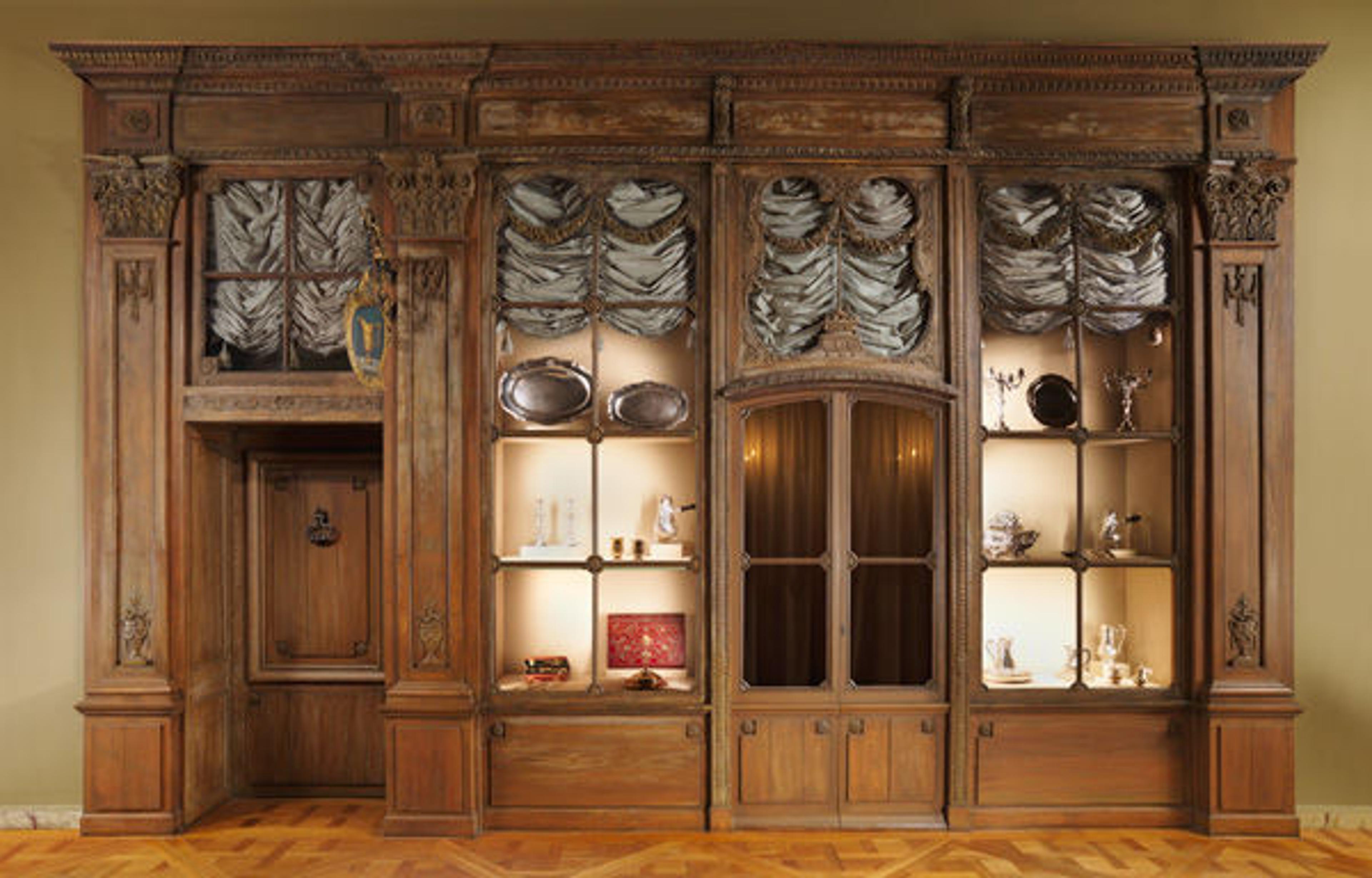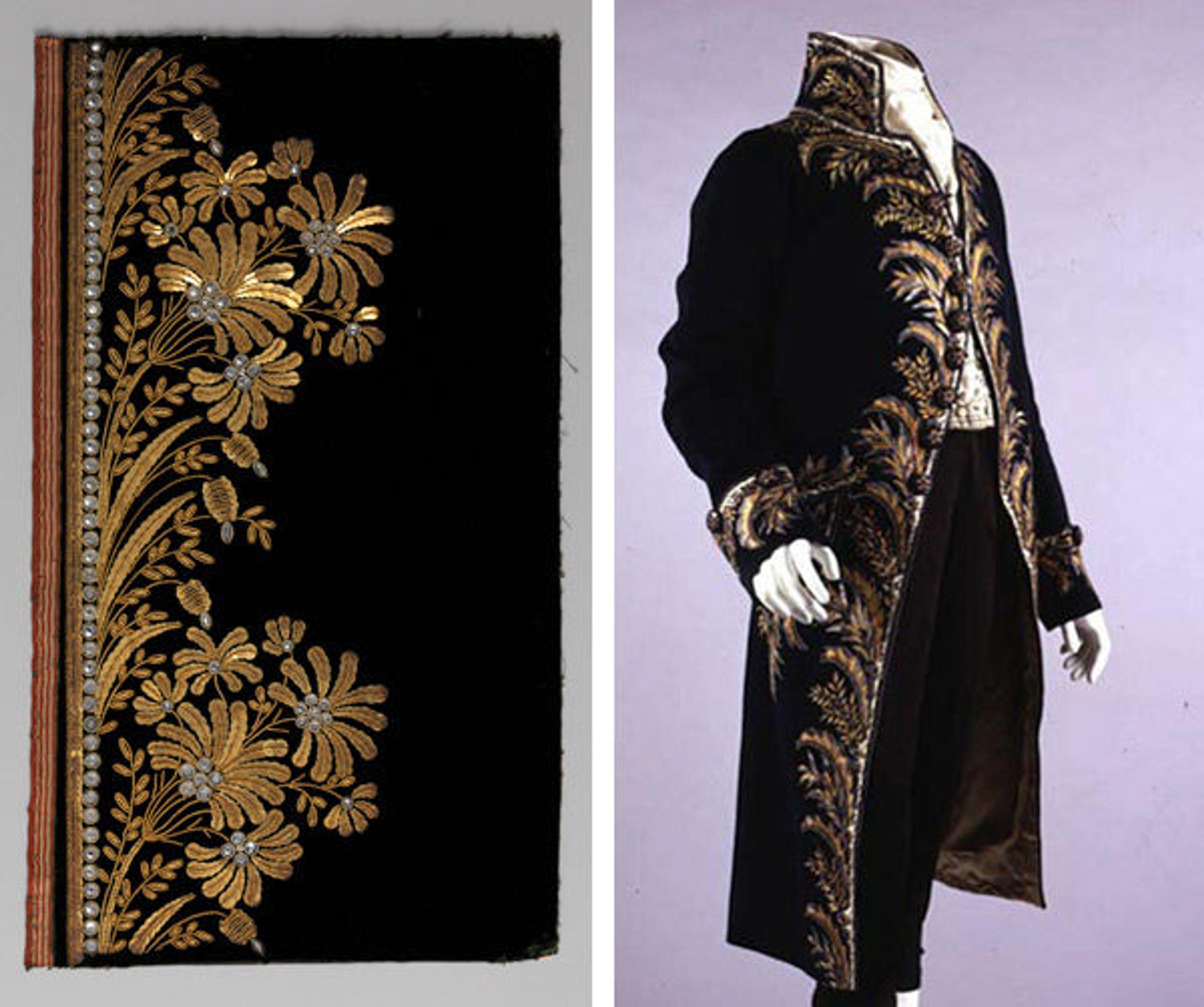The Decoration of Men's Fashion in Eighteenth-Century France

Etienne Séjournant (master in 1772). Shopfront from 3, quai de Bourbon, Île Saint-Louis, Paris, between 1775–77, with later replacements. French, Paris. Oak. The Metropolitan Museum of Art, New York, Gift of J. Pierpont Morgan, 1920 (20.154)
«In the eighteenth century, promenading among the shops along the rue St. Honoré became a fashionable leisure activity for men and women alike. This street was home to Paris's marchands merciers (known as "mercers" in English), a class of merchants who dealt in all manner of luxury goods, including textiles for furnishing and clothing. The mercers' exclusive right to finishing work—arranging for the addition of embroidery, buttons, braids, and sequins through a network of specialized workers—allowed their customers to choose the exact colors and patterns they wanted at the point of sale. The range of embroidery samples currently displayed in the exhibition Elaborate Embroidery: Fabrics for Menswear before 1815, on view through July 19, offers a small window into the level of decoration and customization possible for fashionable men of the late eighteenth and early nineteenth century.»
The merchants of Paris sold their wares from elaborately painted, carved, and decorated shop fronts, each identified by the merchant's sign. Beginning around the mid-eighteenth century, the French began to adopt the English practice of glazing shop windows, which fostered the use of an ever-changing window display as a means to entice potential customers; thus the concept of window shopping was born. Today, visitors to the Museum can see an example of this type of facade installed in the Wrightsman Galleries for French Decorative Arts. Originally built in the 1770s and modified to some extent before entering the Museum, the shopfront from 3, quai de Bourbon, Île Saint-Louis (on view in gallery 545) demonstrates the emphasis Parisian shop owners placed on outward display, which prompted the Englishman Daniel Defoe to complain in 1726:
The French are eminent for making for making a fine outside, when perhaps they want necessaries; and indeed a gay shop and a mean stock, is something like one of those people, with his laced ruffles without a shirt.
Once inside a merchant's shop, customers were able to peruse a variety of goods in a showroom-like setting far removed from the workshops where luxury goods were actually produced. While some clients dealt directly with print merchants who specialized in embroidery patterns, most men chose the decorative trimmings for their jackets and waistcoats from small embroidery samples assembled by the merchant, and often they deferred to the merchant's intimate knowledge of the latest fashions.
Although the merchant did none of the practical work himself, he acted as a mediator between customer and maker—negotiating the costs of labor and materials, and arriving at a final price for an individual embroidered design. Generally such lavish items were purchased on credit, as most of the merchant's trade operated on a "take now, pay later" basis. Perhaps this explains why, as the author of The Art of the Embroiderer noted in 1770, customers were not deterred by embroidered fabrics for men's suits that cost much as six hundred francs per aune (approximately 1.2 meters, or 1.3 yards).

Left: Embroidered panels for a man's suit, 1780s. French. Silk embroidery on woven silk. The Metropolitan Museum of Art, New York, Purchase, Irene Lewisohn and Alice L. Crowley Bequest, 1982 (1982.290a–e)
The merchant would not be responsible for assembling the embroidered pieces into a garment—that was the job of the tailor—but as can be seen from the uncut waistcoat and suit panels on view in the exhibition, panels of silk or wool would be embroidered to reflect the shape of the finished garment. The small embroidered circles seen along the right edge of the panel at left would have formed buttons, the embroidered strip at the left would have decorated the jacket's back vent, and the main embroidery would have formed the front left of the jacket, complete with an elaborate pocket flap.
The late eighteenth and early nineteenth century witnessed a general trend toward greater simplicity in French men's fashion, inspired by unadorned English country dressing. However, waistcoats remained an acceptable outlet for elaborate embroidery, and the new austerity did not preclude the sumptuous decoration seen on court suits of the early nineteenth century. Although the base fabric of the coat below, from 1809, is wool broadcloth rather than silk velvet, its heavy gold embroidery with paillettes and braid bears a remarkable similarity to one of the larger embroidery samples now on view. In fact the often subtle variations on certain motifs seen in the samples on display demonstrate that male consumers of fashion generally adhered to established decorative themes, customizing them through their choice of fabric, color, scale, and trimmings.

Left: Embroidery sample for a man's suit, 1800–1815. French. Metal thread, sequins, and glass on silk velvet. The Metropolitan Museum of Art, New York, Gift of The United Piece Dye Works, 1936 (36.90.19). Right: Coat, 1809. French. Wool, silk, metallic. The Metropolitan Museum of Art, New York, Gift of Miss Geraldine Shields and Dr. Ida Russell Shields, 1948 (C.I.48.14.3)
Additional Reading
Saint-Aubin, Charles German de. Art of the Embroiderer, translated and edited by Nikki Scheuer. Los Angeles: Los Angeles County Museum of Art, 1983 [1770].
Little, Frances. "The Besselièvre Collection of Textiles." In The Metropolitan Museum of Art Bulletin 31, no. 10 (October 1936): 204–6.
Sargentson, Carolyn. Merchants and Luxury Markets: The Marchands Merciers of Eighteenth-Century Paris. London and Malibu: Victoria and Albert Museum in association with the J. Paul Getty Museum, 1996.
Kisluk-Grosheide, Daniëlle, and Jeffrey Munger. The Wrightsman Galleries for French Decorative Arts. New York: Metropolitan Museum of Art, 2010.
Kirstin Purtich
Kirstin Purtich was formerly an intern in the Department of European Sculpture and Decorative Arts.